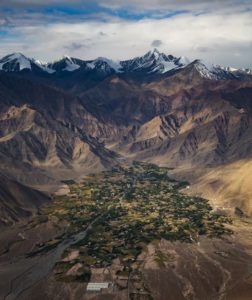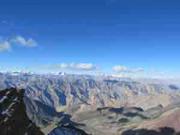

+91-9419333393
cwangdus@gmail.com
Do not hesitate to give us a call. We are an expert team and we are happy to talk to you.
+91-9419333393, +91-9469867272, +91-(0)1982- 255223
cwangdus@gmail.com


Duration : 8 Days
Grade : Easy+
Winding deep through the interiors of Hemis National Park, the Spituk-Matho trek is a doorway to exotic wildlife species like the Himalayan marmot, wild mouse, blue sheep, and the elusive snow leopard. A fairly easy trek, the trail cuts past a handful of Ladakhi villages that portray the simple lifestyle of the natives. Rising up on one side, the lofty Stok Kangri peak plays witness to the trek, while a sprawling canvas of the snowy massifs adorn the backdrop as you climb up to the passes of Stok la and Matho La. The trail also snakes through the beautiful Rumbak valley, which is known almost exclusively to harbor snow leopards. National Geographic made an award winning documentary in the Rumbak valley on Snow Leopards
NOTE:- All the itineraries can be customized to suit your own special interests, preferences, abilities, extension and reduction of numbers of days.
Our services start with your arrival at Leh airport. Meet & greet and transfer to the Hotel. Welcome drink on arrival. We recommend you completely relax for the rest of the day to enable yourselves to acclimatize to the rarefied air at the high altitudeanda successful trek in Ladakh requires you to acclimatize well with high altitude, tourist can explore the Leh market and shanti stupa in the evening only if you feel fine. O/N hotel
After breakfast take a full day excursion to renowned monasteries and palaces of Ladakh region. Founded in 1433 by Palden Sherab, Thiksey monastery the beautiful village of Thiksey, dominated by an imposing Gelugpa monastery. This Thiksey monastery majestically overlooks the valley, a magnificent group of about 80 monks; discovery of the beautiful inner courtyard which distributes access to the various temples. The most amazing is certainly the temple of Maitreya with its gigantic interior statue which covers all floors of the building. To join the next site, we will take the path of school children.
Founded in 1632 by Lama Staktsang Raspa, Visit Hemis Monastery, it is a Tibetan Buddhist monastery of the Drukpa Lineage. The monastery houses an amazing collection of the age-old relics such as the idol of Lord Buddha made up of copper gilt, gold and silver stupas It holds the distinction of being the biggest as well as the wealthiest monastery of Ladakh. The annual Hemis festival honoring Padmasambhava is held here in June.
On the way back to Leh visit Shey (Built in 17th century by king Deldan Namgyal) capital of ancient Ladakh, is an interesting complex whose importance is still measured by the quality of the paintings and the astonishing quantity of chortens or other votive monuments that surround it, especially the copper gilt statue of lord Buddha. The Rock-carved statue of five Buddha can be seen below the palace on the roadside, which was probably carved during the reign of Singay Namgyal.
And the Stok Palace built in 1825th by king Tsespal Tundup Namgyal , residence of the present kings of Ladakh. Transformed into a museum, the collections presented evoke a recent past where the royal family ruled over this valley. O/N hotel.
Elevation gain +590m / elevation loss -0m
After having the breakfast, drive to Zingchen and start walking through Zingchen Gorge. As we continue trekking further, the gorge gets narrower and rugged. On the way one might see snow leopard signs along the valley. As you approach Rumbak fields the valley suddenly opens up with snow capped mountains in the background. From the fields the path turns left eastwards for the Rumbak village. We can explore the higher places of Rumbak village, possibilities of seeing Blue sheep, the Great Tibetan sheep or the Argali, various mountain and migratory birds, high altitude flora and occasionally a Tibetan Wolf or a Snow leopard if luck favors. O/N camp
Elevation gain +900m / elevation loss -850m
The trail up to the base of Stok La (4900m) starts fairly gradual but becomes steeper as we approach the pass. From the pass, we descend along the mountainside up and down until we reach small houses, use by the Stok villagers for summer pasture. Our campsite at Mankarmo (4000m) is also a first camp for the Stok Kangri expedition . The rest of the day will be spent viewing the magnificent Stok Kangri. O/N camp
Elevation gain +370m /elevation loss -420m
Our day begins with a gradual walk towards Matho La 4850m. The trail down from the pass is fairly easy descending into Matho gorge. The walk in between the gorge displays beautiful color of the rock formation. Our camp for tonight lies ahead nearby stream. O/N camp
Elevation gain +0m / elevation loss -900
We will continue our trail through the beautiful gorge, which will lead us to Matho village. Matho is scenic village with its monastery perched on a hill. (Founded by Lama Tungpa Dorje in the year 1410, Matho is the only monastery that follows the Sakya sect of Buddhism. One of the main attractions of Matho Gompa is Matho Nagrang Festival. This is held on 14th and 15th day of the 1st Tibetan calendar. After visiting the monastery and enjoying the view of the surrounding landscape we will drive back to Leh. O/N hotel
Free day for personal activities. O/N hotel
Early morning transfer to Leh airport to board flight back to destination. Tour ends with sweets memories.
For the more adventurous a drive to either Manali or Srinagar can also be arranged on request. The road journey is covered in two or more days with an overnight halt at either Sarchu or Jispa, which lies on the Leh-Manali highway, or Kargil, which lies on the Leh-Srinagar highway.
Pay heed to the guidelines given by trek leader or instructor in order to enjoy a safe and sound trekking experience.
Avoid trekking during the nights. Single rooms and tents can be requested for a supplement (subject to availability). Please enquire at the time of booking.
Ladakh is very safe, tourist friendly and cheering place, but still you need to take care of some preparations which can make your tour even better and memorable: Carry headache, stomachache, anti-vomiting tablets with you. Please respect the culture of Ladakh. We are providing world class services in the secluded place, which is similar to an oasis, is very difficult and challenging. Still we try our best to bring cheer on your faces.
Code of Ethics for tourists visiting Ladakh
a. As a Guest – Respect local traditions- protect local cultural- maintain local prides.
b. While taking Photographs- Respect privacy-ask permission and restraint use of flashlight for photography and filming inside National Monuments and smoking and alcohol drinking is strictly prohibited
c. Respect Holy Place- preserve what you have come to see- never touch or remove religious objects- purchase and sale of antiques which is more than 100 years old is against the law and it attracts punishment under rules.
d. Keep stream water clean and avoid using pollutants such as detergents in stream and springs- if no toilets facilities are available- make sure are at least 30 Meter away from water source and Bury or cover waste.
e. Giving to Children encourages begin- a donation to project like Health Centre or School is a more constructive way to help.
f. Visitors who value local traditions encourage local prides and maintain local cultures-please help them to gain a realistic view of life in other parts of the World.
g. The beauty of the place and loving kinds of the people may change you but please do not change them.
Eating and Drinking
Whilst camping, the staff will bring a hot drink (usually tea) to your tent each morning. When you reach camp in the afternoon tea and biscuits will be served. At breakfast, dinner and in the afternoons, there is a choice of hot drinks. Breakfasts typically include cereal, toast and jam, eggs and porridge. Lunch on trek is usually served as a picnic en route (except on shorter days when it is in camp). Lunch and dinner typically include soup to start, followed by a variety of hot dishes (both local and western) such as potatoes/chips, vegetables, curry, pasta, rice, dal and paneer (cottage cheese). At dinner time a dessert such as tinned fruit and custard, fritters or cake is also be served.
Note:- that although some meals will include meat, it is not as readily available while camping.
Drinking Water
Staying hydrated is important when undertaking any physical activity but particularly so at altitude where it is generally recommended to drink at least 3-4 litres per person per day.
We strongly encourage you not to buy bottled water as this contributes to the growing problem of plastic pollution in Ladakh. In Leh there is a shop called Dzomsa which sells safe drinking water. Your leader will show you where this is on your first day in Leh.
During the trek the cooks will collect and boil drinking water from the mountain streams and fill up your water bottles for you, but you may need to collect water during the day and may wish to use your own water purification treatment as well.
We also suggest that you may like to bring a reusable bottle with a wide opening (Nalgene or similar)
Weather
The above weather chart for Leh shows average temperatures only – it does not reflect extremes of heat and cold. Generally the weather is good in Ladakh during the summer time, with warm to very hot sunny days (up to 30ºC/35ºC+) with cooler nights depending on the altitude (it can reach freezing point at some higher places in September). There is, however, the possibility of rain, and you should be prepared for this. The sun is very strong at these altitudes and some of the days on trek can be extremely hot.
Ladakh, though technically part of the Tibetan plateau and classified as a high altitude desert, can and does occasionally experience the effects of the Indian monsoon. Although the departures are timed to coincide when the weather is normally good, you should remember that in any mountain area the weather is never wholly predictable and you should be prepared and equipped to deal with any differences in weather beyond the conditions described above.
Note:- While on a trek or expedition in a remote area if any client suffers from altitude sickness or any other serious injury, the sirdar/guide sends a runner to the nearest telephone/army post/road head to ask for help. Emergency evacuation becomes necessary in the following cases:High Altitude Sickness – If the client suffers from High Altitude Sickness, he/she needs to descend immediately. Injury – In case the client is badly injured – broken bones/fractures or sickness like thrombolysis (blood clotting), paralysis, loss of eyesight – in these cases as well he/she needs to be evacuated/descend immediately.
What to bring
Hiking trousers and shirts, warm jackets, pullovers and raincoat Good hiking shoes Flash light Sun hat/baseball cap Sunglasses, Lip balm Sun lotion cream and toiletries
